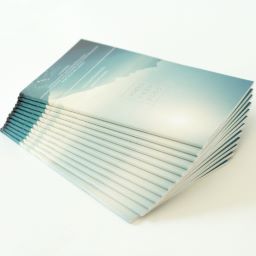Unlock the Power of Augmented Reality in Your Booklet Printing Projects
Unlock the Power of Augmented Reality in Your Booklet Printing Projects
Blog Article
The Important Guide to Recognizing Booklet Printing Options and Techniques
The process of pamphlet printing entails several considerations that can significantly impact the last product. From selecting the appropriate layout and size to understanding the nuances of binding methods, each selection plays a necessary function. Additionally, factors such as paper stock and printing methods further affect the efficiency of the booklet. As one navigates these choices, it becomes important to grasp exactly how they adjoin and what that indicates for the overall end result.
Comprehending Pamphlet Sizes and layouts
When considering pamphlet printing, comprehending the different styles and dimensions offered is essential for attaining the desired presentation. Pamphlets can be created in countless formats, consisting of saddle-stitched, spiral-bound, and perfect-bound, each offering distinct benefits. Usual dimensions vary from typical letter (8.5 x 11 inches) to smaller alternatives like A5 (5.8 x 8.3 inches), permitting versatility based on material and target audience.Selecting the ideal size can affect both the design and reader interaction. Bigger sizes may match visually driven web content, while smaller styles might be extra mobile and easy to use. In addition, the number of pages influences the choice of binding technique, as thicker pamphlets may call for tougher bindings. Ultimately, recognizing these facets enables for a more tailored technique, making certain that the end product straightens with the desired message and visual, enhancing the overall efficiency of the communication.
Picking the Right Paper Supply

Binding Methods: Considerations and options
When it concerns binding approaches for brochures, several choices are offered, each with distinct advantages. Saddle stitch binding uses a cost-effective option for thinner pamphlets, while ideal binding strategies provide a more polished seek thicker magazines. Wire-O binding stands apart for its toughness and simplicity of usage, making it optimal for papers that call for adaptability.
Saddle Stitch Binding
Saddle stitch binding supplies a cost-effective and practical service for putting together brochures, making it a prominent selection amongst authors and organizations. This binding approach involves folding sheets of paper in half and stapling them along the fold line, creating a well organized and cool look. Generally suitable for pamphlets with a reduced web page count, saddle stitching is perfect for magazines, pamphlets, and training materials. The simplicity of this method permits quick manufacturing and is usually preferred for brief runs or promotional things. Nonetheless, it is necessary to note that saddle stitch binding might not be ideal for thicker brochures, as the spine might not stand up under boosted weight. In general, it remains a trusted choice for numerous printing tasks.
Perfect Binding Methods
Perfect binding is a widely used method that provides a refined and professional surface to magazines and booklets. This approach involves gluing the web pages together at the spinal column utilizing a strong adhesive, permitting a tidy edge and the capacity to hold a larger variety of web pages contrasted to saddle stitching. Perfect binding is especially suitable for thicker brochures, such as catalogs and annual records, where a durable, level back is desired. Furthermore, it offers the choice for a printed cover that can be created to enhance aesthetic allure. However, considerations such as page count, paper weight, and the planned use the brochure must be thought about, as they can influence longevity and total quality.
Wire-O Binding Choices
Wire-O binding, recognized for its durability and flexibility, uses a superb option for booklets that require easy page turning and a professional appearance. This binding technique utilizes a series of metal loops that hold pages safely, enabling them to lie flat when open. It is particularly ideal for presentations, catalogs, and guidebooks due to its durable nature. Wire-O binding is offered in numerous shades and diameters, accommodating various web page matters and densities. Furthermore, it permits the visit this site right here inclusion of tabs and covers, boosting the pamphlet's total visual. Considerations for Wire-O binding include the selection of cable color, the dimension of the loopholes, and the degree of personalization preferred, all of which can greatly affect the end product's appearance and performance.
Digital vs. Offset Printing: Which Is Best for You?
When selecting a printing approach for brochures, comprehending the distinctions in between digital and counter printing is necessary. Digital printing utilizes modern technology to generate top notch prints quickly and affordably, making it excellent for short runs or tasks needing quick turn-around times. It permits customization, providing the capacity to print on-demand with minimal waste.In comparison, balance out printing is a traditional approach that masters generating huge quantities with regular high quality. It entails transferring ink from a plate to a rubber covering, after that to the paper, which causes vibrant shades and precise details. However, balance out printing typically needs longer arrangement times and is extra economical for bigger volumes.Ultimately, the choice between electronic and offset printing relies on project needs, budget plan, and wanted quantity. For small, time-sensitive projects, electronic might be the finest option, while countered might be preferable for larger, top notch manufacturings.

Creating Your Pamphlet: Tips and Best Practices
When developing a booklet, careful focus to format, font style choice, and shade usage can considerably enhance its performance. A well-structured design guides the viewers's eye, while appropriate typefaces ensure readability and convey the desired tone. In addition, reliable use color can stimulate feelings and highlight vital info, making the general design extra impactful.
Selecting the Right Layout
Just how can one properly pick the ideal layout for a pamphlet? It is important to review the brochure's purpose and target audience. A tidy, organized design enhances readability and engagement. Using a grid system can assist in aligning components regularly, developing an expert look. In addition, integrating aesthetic pecking order via varying dimensions and placements of pictures and text can guide the visitor's eye and stress essential details. It is likewise important to leave enough white space, which stops congestion and permits much better focus. Checking different layouts with mock-ups can supply understanding right into just how the layout does in real-world circumstances, ensuring that the final product meets both visual and functional requirements. Practical Choosing Proper Font Styles
An appropriate typeface can greatly enhance the overall design of a brochure, matching the design and strengthening the material's message. The choice of font styles need to consider readability, especially for body message, as it assures the details comes to all visitors. Sans-serif typefaces are often preferred for electronic layouts, while serif typefaces can provide a typical feeling in published products. It's recommended to limit font choices to 2 or 3 to preserve aesthetic coherence. In addition, font size plays an essential duty; headings need to be distinctive however not overwhelming, while body message must be comfortable for reading. When choosing fonts, placement with the booklet's theme and target market is vital for effective communication and aesthetic allure.
Efficient Use of Shade
Shade acts as a powerful device in booklet style, shaping assumptions and leading viewers feelings. It can evoke feelings of calmness, enjoyment, or trust fund, depending on the colors selected. Designers should consider color concept concepts, guaranteeing that the picked palette lines up with the pamphlet's message this content and target market. For instance, utilizing cozy colors like red and orange can develop seriousness, while cooler tones like blue and environment-friendly foster tranquility.Additionally, contrast plays a crucial function; corresponding colors can improve readability and aesthetic allure. Consistency in color use throughout web pages further strengthens brand identity and cohesion. Inevitably, reliable shade application not only catches interest however likewise reinforces the booklet's function, making it a necessary facet of effective style.
Completing Touches: Coatings and Special Results
While many consider the content and format of a pamphlet one of the most important components, the finishing touches, such as coverings and special results, play a crucial duty in improving its overall allure. Coatings can give security and longevity, making sure that the brochure endures wear and tear. Matte coatings use an advanced, non-reflective surface, while glossy finishes can make colors appear even more dynamic and attractive. Special impacts, like embossing or foil marking, add a responsive measurement that can create an unforgettable impression. These strategies can highlight particular locations, attracting interest to essential details or producing aesthetic rate of interest. In addition, UV coating can give a high-shine surface that boosts the general look.Together, these ending up touches not only boost the brochure's aesthetic however also interact professionalism and focus to detail, inevitably leaving an enduring impact on the visitor.
Price Considerations for Brochure Printing
Recognizing the various price factors to consider for brochure printing is necessary for services and organizations intending to maximize their budgets. Secret factors affecting expenses consist of the selection of binding, ink, and paper techniques. Higher quality materials, such as superior paper or specialized inks, normally raise the total cost. In addition, the dimension and web page matter of the booklet play a considerable function; larger brochures require even more sources and time to produce.Another important consideration is the printing strategy, whether electronic or balanced out, as each has its own rates framework and viability for different amounts. Services ought to additionally consider design expenses, which can vary based upon intricacy and the usage of specialist solutions. Inevitably, delivery and handling fees can add to the total, particularly for huge orders. By examining these aspects, organizations can make educated choices that straighten with their economic abilities while accomplishing the desired top quality in their printed materials.
Frequently Asked Questions
What Are the Environmental Effects of Brochure Printing?
The ecological influences of pamphlet printing include deforestation from paper production, carbon exhausts from transportation, and waste generation from discarded materials - Booklet Printing. Sustainable methods, such as making use of recycled paper and environmentally friendly inks, can alleviate these effects
Just How Can I Guarantee Color Accuracy in My Brochure?
To ensure color accuracy in a pamphlet, one must use adjusted displays, employ expert color profiles, perform examination prints, and select high-quality printing services that provide color matching and proofing alternatives for ideal results.
What Is the Common Turn-around Time for Pamphlet Printing?
The normal turnaround time for pamphlet printing varies depending upon the complexity and quantity - Booklet Printing. Usually, it ranges from a couple of days to 2 weeks, influenced by factors such as publishing techniques and finishing requirements
Exist Minimum Order Quantities for Brochure Printing?

Can I Print Booklets in Numerous Languages?
Publishing pamphlets in multiple languages is possible. Several printing solutions offer options for multilingual or multilingual designs, permitting for effective communication. Cautious preparation warranties that design aspects suit various languages without endangering readability or aesthetic appeals. In addition, variables such as paper stock and printing techniques further influence the effectiveness of the brochure. When taking into consideration pamphlet printing, comprehending the various formats and sizes readily available is essential for attaining the desired discussion. When picking a printing method for pamphlets, comprehending the distinctions between digital and balance out printing is crucial. In addition, the dimension and page matter of the booklet play a considerable role; bigger pamphlets require more sources and time to produce.Another important consideration is the printing method, whether digital or balanced out, as each has its very own prices structure and viability for various amounts. The environmental impacts of pamphlet printing consist of deforestation from paper production, carbon emissions from transportation, and waste generation from disposed of products.
Report this page